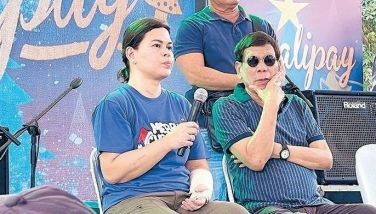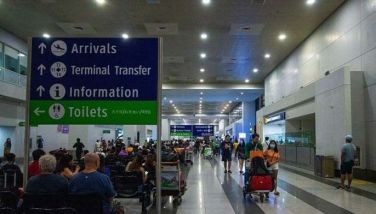Al-Qaeda used RP as testing ground for major attacks
March 17, 2007 | 12:00am
The Philippines was a testing ground in the 1990s for al–Qaeda’s major attacks, according to a confidential document obtained by The Associated Press.
Captured terror suspect Khalid Sheikh Mohammed’s key role in the al–Qaeda plot to simultaneously bomb the commercial planes flying out of Asia – in a 1995 plan called "Project Bojinka" – was one of several admissions that he made, the US Defense Department said.
Defense Department officials released a transcript of Mohammed’s confessions, detailing his claims of roles in 31 terror plots worldwide, during a hearing at Guantanamo Bay prison.
"I was responsible for the planning and surveying needed to execute the Bojinka operation, which was designed to down 12 American airplanes full of passengers," the transcript quoted Mohammed as saying.
Two top al–Qaeda operatives smuggled explosive ingredients onto flights from Manila and Hong Kong in 1994 as part of a test run for a failed plot to blow up 12 US–bound airliners.
Mohammed said he personally monitored "a round–trip, Manila–to–Seoul, Pan–Am flight."
Police Chief Superintendent Rodolfo Mendoza, who was among several officers who tried to track down Mohammed and convicted terrorist Ramzi Yousef in Manila said the attacks could have killed thousands of people had they been carried out.
"I have to warn though that these plots could still be resurrected and these class–A terror leaders may have been replaced," he told The Associated Press on Friday.
A separate confidential document on the US interrogation of Mohammed, which was shared with Philippine officials, provided details on how he managed to smuggle explosive ingredients onto a Manila–to–Seoul flight in 1994.
The US intelligence document also detailed how Mohammed’s nephew, Yousef, conducted the same test on a flight from Hong Kong to Taipei.
The AP obtained a copy of the report on Mohammed’s interrogation, conducted in mid–April 2003 while he was in US custody.
According to the document, Mohammed admitted that he hand–carried an explosive chemical called concentrated nitromethane, concealed in 13 bottles of contact lens solution, during his trip, and also said Yousef carried one bottle of the explosive on his flight. They bought the readily available chemical in the Philippines, Mohammed said.
In an effort to test his ability to smuggle a detonator past airport security, Mohammed said he wore a bolt taped to the sole of his foot, then covered it with socks. The two also wore clothing with metal buttons and jewelry to mislead security in case the bolt activated metal detectors.
"The detainee said that he and Ramzi placed condoms in their bags to support their cover story that they had traveled to the Philippines to meet women," the report said, adding that Mohammed also put batteries and wires in his bag.
While checking in at the Manila airport, Mohammed said he was pulled aside for not having a visa to enter Seoul, prompting him to pretend that the South Korean embassy in Manila told him he did not need a visa.
He went through a metal scanner twice and his bag was searched. Asked about the number of bottles of contact lens solution, Mohammed replied that he stocked up because they were cheaper in the Philippines and that he needed the wires and batteries for his work as an engineer.
Mohammed said he also accidentally left a copy of the Bojinka plan in his bag, listing the 12 flights targeted for bombings, with the Manila–Seoul flight highlighted. A security man noticed the highlighted flight but "he did not pay attention to it since it was the flight (Mohammed) was scheduled to take," the report said.
Airport security agents also asked Mohammed to remove his shirt, pants and shoes, which were scanned with a metal detector wand, then returned to him. The guards did not notice the bolt taped to his sole that was hidden under his sock, the report said.
Prior to boarding, Mohammed’s bag was searched again, and airport security agents removed the batteries. He got on the flight but was not allowed to enter Seoul because he had no visa and was sent back to Manila, where the batteries were returned to him, the report said.
He bought a ticket to Karachi, Pakistan, where he had arranged to meet Yousef, the report said.
Yousef was captured in 1995 and Mohammed in 2003 in Pakistan. Yousef was convicted in the United States for his role in the Manila air plot and the 1993 attack on the World Trade Center.
He also was convicted of killing a Japanese passenger with a liquid bomb on a Japan–bound Philippine Airlines jet in 1994 that US prosecutors called a test run for the Bojinka plan. – AP
Captured terror suspect Khalid Sheikh Mohammed’s key role in the al–Qaeda plot to simultaneously bomb the commercial planes flying out of Asia – in a 1995 plan called "Project Bojinka" – was one of several admissions that he made, the US Defense Department said.
Defense Department officials released a transcript of Mohammed’s confessions, detailing his claims of roles in 31 terror plots worldwide, during a hearing at Guantanamo Bay prison.
"I was responsible for the planning and surveying needed to execute the Bojinka operation, which was designed to down 12 American airplanes full of passengers," the transcript quoted Mohammed as saying.
Two top al–Qaeda operatives smuggled explosive ingredients onto flights from Manila and Hong Kong in 1994 as part of a test run for a failed plot to blow up 12 US–bound airliners.
Mohammed said he personally monitored "a round–trip, Manila–to–Seoul, Pan–Am flight."
Police Chief Superintendent Rodolfo Mendoza, who was among several officers who tried to track down Mohammed and convicted terrorist Ramzi Yousef in Manila said the attacks could have killed thousands of people had they been carried out.
"I have to warn though that these plots could still be resurrected and these class–A terror leaders may have been replaced," he told The Associated Press on Friday.
A separate confidential document on the US interrogation of Mohammed, which was shared with Philippine officials, provided details on how he managed to smuggle explosive ingredients onto a Manila–to–Seoul flight in 1994.
The US intelligence document also detailed how Mohammed’s nephew, Yousef, conducted the same test on a flight from Hong Kong to Taipei.
The AP obtained a copy of the report on Mohammed’s interrogation, conducted in mid–April 2003 while he was in US custody.
According to the document, Mohammed admitted that he hand–carried an explosive chemical called concentrated nitromethane, concealed in 13 bottles of contact lens solution, during his trip, and also said Yousef carried one bottle of the explosive on his flight. They bought the readily available chemical in the Philippines, Mohammed said.
In an effort to test his ability to smuggle a detonator past airport security, Mohammed said he wore a bolt taped to the sole of his foot, then covered it with socks. The two also wore clothing with metal buttons and jewelry to mislead security in case the bolt activated metal detectors.
"The detainee said that he and Ramzi placed condoms in their bags to support their cover story that they had traveled to the Philippines to meet women," the report said, adding that Mohammed also put batteries and wires in his bag.
While checking in at the Manila airport, Mohammed said he was pulled aside for not having a visa to enter Seoul, prompting him to pretend that the South Korean embassy in Manila told him he did not need a visa.
He went through a metal scanner twice and his bag was searched. Asked about the number of bottles of contact lens solution, Mohammed replied that he stocked up because they were cheaper in the Philippines and that he needed the wires and batteries for his work as an engineer.
Mohammed said he also accidentally left a copy of the Bojinka plan in his bag, listing the 12 flights targeted for bombings, with the Manila–Seoul flight highlighted. A security man noticed the highlighted flight but "he did not pay attention to it since it was the flight (Mohammed) was scheduled to take," the report said.
Airport security agents also asked Mohammed to remove his shirt, pants and shoes, which were scanned with a metal detector wand, then returned to him. The guards did not notice the bolt taped to his sole that was hidden under his sock, the report said.
Prior to boarding, Mohammed’s bag was searched again, and airport security agents removed the batteries. He got on the flight but was not allowed to enter Seoul because he had no visa and was sent back to Manila, where the batteries were returned to him, the report said.
He bought a ticket to Karachi, Pakistan, where he had arranged to meet Yousef, the report said.
Yousef was captured in 1995 and Mohammed in 2003 in Pakistan. Yousef was convicted in the United States for his role in the Manila air plot and the 1993 attack on the World Trade Center.
He also was convicted of killing a Japanese passenger with a liquid bomb on a Japan–bound Philippine Airlines jet in 1994 that US prosecutors called a test run for the Bojinka plan. – AP
BrandSpace Articles
<
>
- Latest
- Trending
Trending
Latest
Trending
Latest
Recommended





























